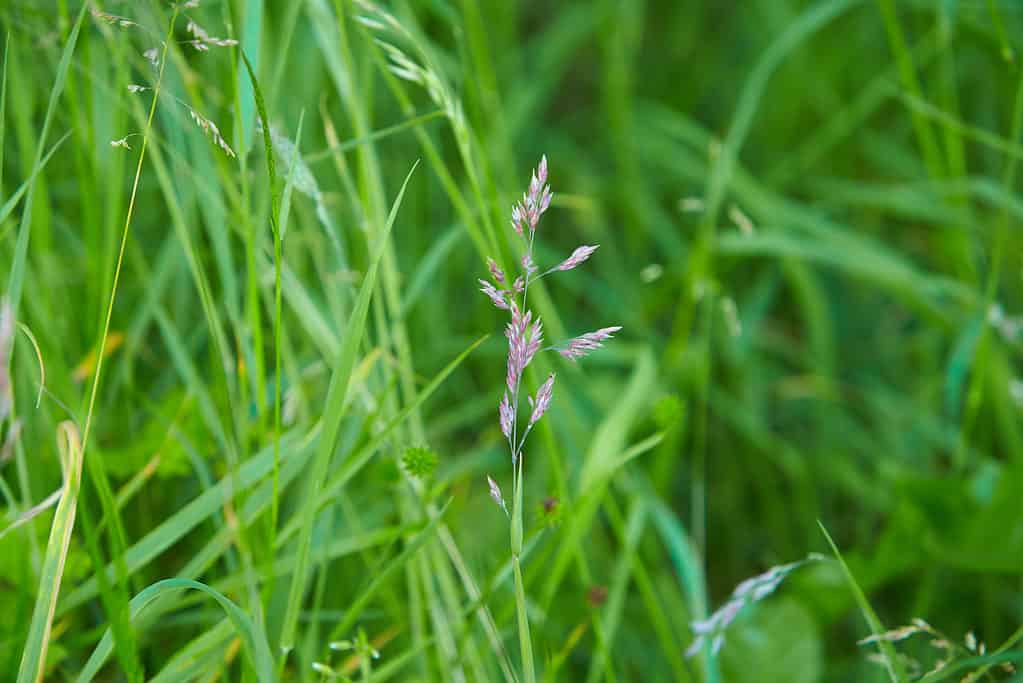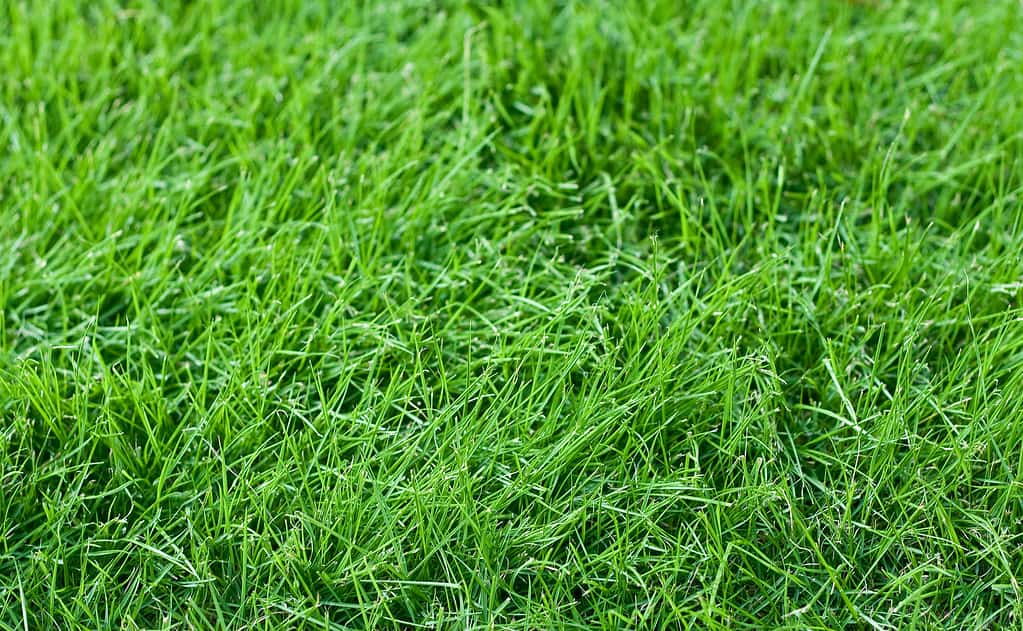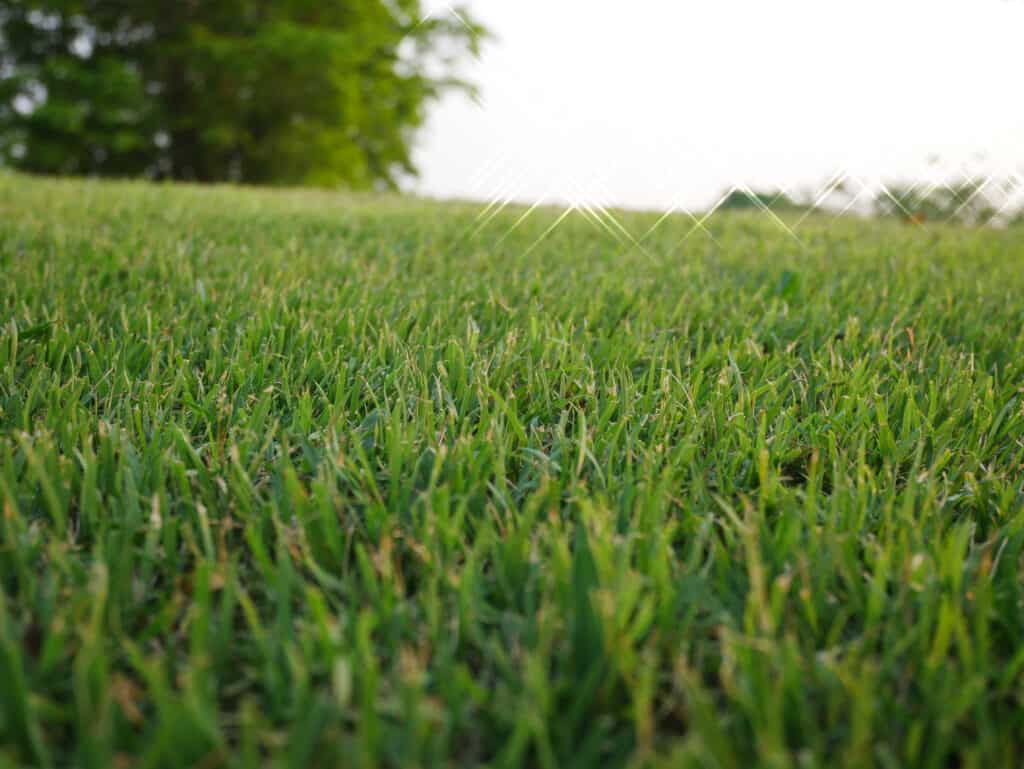When choosing suitable turf grass, there are seemingly endless options. Two popular choices are Bermuda vs. fescue. While they may seem like decent options for low-maintenance landscaping, they’re distinctly different. With water conservation in mind, both types of grass may seem like obvious choices because they require little watering. However, there is more to consider.
From appearance to adaptability, there are several key differences to remember. Knowing these grasses’ differences helps you decide what’s best for your green space. This article explores 14 critical differences between Bermuda grass and fescue. So, roll up your sleeves, grab a cold drink, and let’s dive in and learn more.
Bermuda Grass vs. Fescue – Definition
Before we dwell on the difference between Bermuda grass and fescue, let’s look at their definitions.
Tall fescue Grass
Tall fescue grass is popular among homeowners worldwide. It’s a common grass species in the northern US. It’s resistant to drought and thrives in cooler weather. This durable and hardy grass is excellent for sports fields and parks.
This is because it can withstand constant foot traffic without wear and tear. It’s a low-maintenance option that tolerates cold weather. Its root system is deeper than other grass varieties. This makes it less prone to drought and heavy rainfall damage.
With its toughness and adaptability, Tall fescue grass is an excellent option for those looking for an easy-to-maintain, resilient lawn.
Pros of Tall fescue Grass
- Resilient and durable: Withstands cold weather and foot traffic.
- Low maintenance: Tolerates minimal watering and mowing.
- Drought-resistant: Ideal for dry climates and grows well in cooler temperatures.
- Deep root system: Makes it less prone to drought and heavy rainfall damage.
- Suitable for sports fields and parks due to its hardiness and ability to withstand constant foot traffic.
Cons of Tall fescue Grass
- Looks less vibrant in the summer heat: Tall fescue prefers cooler temperatures and may appear less green during warmer weather.
- May grow too tall: Without proper mowing, tall fescue can grow taller than desired.
Despite its cons, tall fescue grass remains popular for those seeking a low-maintenance, hardy lawn. Proper care can add beauty and resilience to any lawn.
Bermuda Grass
Its scientific name, Cynodon Dactylon, may sound fancy, but this grass is anything but pretentious. Originating from Europe, Australia, Africa, and Asia, this warm-weather-loving plant has won lawn lovers’ hearts worldwide.
The US, in particular, loves this grass, considering it a “show grass” due to its stunning aesthetics. It is beautiful, and Bermuda grass seed is also used in pastures and lawns due to its durability. But, like any living organism, it thrives in the right conditions – plenty of sun and good drainage.
Pros of Bermuda Grass
- The vibrant deep green color enhances the lawn’s overall aesthetic.
- Highly resistant to pests and bounces back well from high foot traffic.
- Tolerant to heat, drought, and salt, making it perfect for warm-climate areas.
- Suitable for Hardiness Zones 6 through 11 in lawns with soil pH of 6 to 6.5.
Cons of Bermuda Grass
- They are considered invasive and can quickly dominate surrounding areas.
- Requires high maintenance like watering and weeding to keep it healthy.
- Regular mowing is necessary to maintain its height around 1 to 1½ inches.
- Poor growth in shady areas makes it unsuitable for lawns with ample tree coverage.
As with any other lawn type, Bermuda grass has advantages and drawbacks. While it’s resilient and attractive, its maintenance requirements can be challenging.

Get the perfect lawn you’ve always dreamed of with a beautiful, healthy patch of Bermuda grass! It’s easy to maintain and sure to add curb appeal to your home.
©aimful/Shutterstock.com
Bermuda vs. Fescue Grass- The 14 Differences
You might observe a lawn and think the grass looks the same. However, there are many more differences between fescue and Bermuda grass than similarities. Here’s how these different grass types stack up:
1. Appearance
When choosing grass for your lawn, deciding based on its appearance is expected. Bermuda vs. fescue grasses are two popular options with unique features. Fescue’s grass blades are broad, tall, and coarse. One side of the blade is shiny and smooth. When cared for correctly, it maintains a dark green even in winter.
Bermuda grass has a light green color and thicker, rougher textures. In the morning, when the dew is still wet, you may notice a blue or grayish-green hint of color in different patches of the grass.
Bermuda grass blades are usually short and thinner than fescue. Kansas University research shows that the latter is perfect for ornamental grass or landscaping, while Bermuda works well on golf courses.
With fescue growing to 4 inches tall and Bermuda only reaching 2 inches, both grass types will contribute to a vibrant yard that boosts curb appeal.
2. Climate
Bermuda and fescue grass is great but perform differently in various parts of the country. Bermuda grass, thriving in southern states like Florida, California, and Georgia, requires full sun, hot temperatures, and little water. It thrives in temperatures of 75 degrees Fahrenheit and 95 degrees Fahrenheit.
Anything below slows or halts growth. On the other end of the spectrum, tall fescue grass can tolerate colder temperatures ranging from 55 degrees Fahrenheit to 75 degrees Fahrenheit. It suits northern states like New York, Washington, and Oregon. Although unsuitable for warm regions, fescue grass is increasingly becoming a standard option for shady areas in southern states.
3. Durability
Bermuda boasts of handling high wear and tear easily. Thanks to its unique ability to bounce back quickly. Fescue, on the other hand, is ideal in areas with heavy foot traffic. Despite these two grass types being durable, Bermuda outlasts fescue in high heat and drought.
In contrast, fescue can withstand extreme cold and drought conditions, unlike Bermuda. Another factor to consider is that Bermuda is nearly pest-resistant but vulnerable to fungal diseases, which is not an issue for fescue grass.

Tall fescue grass is the perfect choice for a lush and beautiful lawn.
©iStock.com/Irina Pislari
4. Price
Fescue grass is cheaper. It ranges from $0.35 to $0.65 per square foot. In contrast, Home Guide approximates Bermuda grass at a higher cost. It ranges between $0.35 to $0.85 per square foot or $160 to $385 per pallet, covering about 450 square feet.
Though, if you choose Bermuda sod, the expenses increase as preparation, delivery, and installation fees drive the cost up to $1 to $2 per square foot. The retail price of a pallet is $450 for 450 square feet, while the wholesale price ranges from $130 to $360.
5. Pests and Disease Tolerance
When it comes to lawn care, choosing between Bermuda and fescue grass can be challenging. Both options have unique features, but one key difference lies in their pest and disease tolerance levels.
While Bermuda and fescue grasses offer excellent resistance to common pests and diseases, Bermuda grass can be more susceptible to certain fungal diseases like “spring dead spot” and powdery mildew, caused by the fungi in the genus Ophiosphaerella and Erysiphe graminis, respectively.
Fescue grasses tend to be more disease tolerant, with only a few susceptible fungal diseases like brown patches. However, the good news is that a soil insecticide should keep pests at bay in either case.
6. Mowing Heights
Mowing heights are essential when maintaining Bermuda and fescue grasses. On average, both require a weekly mow to keep them neat, but the ideal mowing height differs. For fescue, the perfect mowing height is between 3 to 3.5 inches.
After seeding or sodding, ensure it attains a height of 4 to 4.5 inches before mowing. It’s vital not to mow more than this, as it may harm your grass. Bermuda is best mowed at a height of 1 to 2 inches, but some hybrid types require shorter trim.
Getting the mowing heights right for your specific grass type will keep it healthy and thriving. Don’t forget to maintain your mower, keeping the blades sharp and in good condition to ensure a clean cut each time you mow. A well-maintained lawn will give your space the enviable, lush green look of every homeowner’s dream.

The perfect shade of green. Bermuda grass is known for its low maintenance and thick, lush texture. It’s perfect for any lawn or garden.
©BLUEwalkerXV/Shutterstock.com
7. Fertilizer
Bermuda and fescue grasses may require similar amounts of nitrogen fertilizer throughout the season, but application timing varies significantly. The optimum time to fertilize Bermuda grass is during late spring through early fall, when it thrives in warmer weather. Applying fertilizer during other periods may not produce the best results and is discouraged.
Fertilizing tall fescue should take place during the spring and fall months. Avoid fertilizing this type of grass during the summer due to increased susceptibility to heat-related diseases. Chelated iron applications can be applied during the summer to enhance the grass’s vibrant green color.
8. Maintenance
Maintaining Bermuda grass and fescue grass requires different levels of care. While both require regular watering and mowing, Bermuda grass demands more attention to achieve a pristine appearance.
To keep Bermuda grass healthy and lush, mow it frequently, and keep it at an average height of 1.5 inches. On the other hand, fescue grass can grow a little taller between mowing sessions, but it’s still essential to maintain its height.
Keeping your lawn’s length consistent will help your grass develop a more resilient root system, resulting in a healthier and greener lawn. When it narrows to maintenance, the main difference between Bermuda and fescue grass lies in the care required to keep them looking their best.
9. Soil Type and pH
When it comes to Bermuda vs. fescue grass, soil type, and pH are significant differences. Bermuda grass grows in any soil type with good nutrient access. Soil quality can be improved by amending it with organic matter. This is regardless of whether it has more clay or sand content. Bermuda grass prefers neutral or slightly alkaline soil.
Although Bermuda grass is sensitive to pH levels, it is still highly tolerant. Texas A&M University recommends a soil pH range of 6.5 to 8.0. fescue grass thrives in well-draining, loamy soil kept slightly acidic at pH levels between 5.5 and 6.5. If the soil is too alkaline, fescue grass struggles to absorb nutrients. This leads to yellowing or browning of the blades.

Fescue loves a slightly acidic soil pH of 5.5-6.5, so ensure to check your lawn’s pH before planting.
©iStock.com/dbvirago
10. Shade Tolerance
Bermuda grass struggles in the shade, making it a less-than-ideal choice for properties with large trees or structures blocking out the sun. This turf grass requires at least 4 hours of direct sunlight daily, and even then, it may not thrive.
While newer cultivars like TifGrand Bermuda offer marginally better shade tolerance at around 50%, it’s still not the best option for a shady yard. Fescue grass has a high shade tolerance, making it an excellent choice for properties with limited sun exposure.
This cool-season grass grows well in partial and full shade, making it a versatile option for homeowners. Whether it’s a bright sunny yard or an area lacking sunlight, fescue grass will adapt and thrive, making it the most suitable choice for those needing shade-tolerant turf.
11. Options and Customizations
Bermuda grass offers a variety of green shades that can be tailored to any preference. Conversely, fescue includes a broader diversity of grass options, with finer or thicker blades and even ornamental blue fescue. This will add variety to your lawn.
Bermuda grass offers around 50 grass types, while fescue provides over 300. This variety allows more flexibility in selecting the perfect grass type to suit your preferences and climate.
12. Professional Uses
Bermuda is a highly adaptable turfgrass that professionals can utilize in many applications, including roadside projects, lawns, and sports fields. Research and innovation have helped develop top-notch Bermuda products that meet varying professional needs.
Fescue grass is primarily used in shady areas where warm-season turfgrass fails to grow, especially in the South’s transition zone. In the transition zone and north, tall fescue is commonly used for lawns and limited sports field applications, usually rough areas on golf courses.

Bermuda grass – the perfect choice for professional landscapers looking to create a beautiful and eye-catching lawn.
©Joyjiraporn/Shutterstock.com
13. Sod and Seed Options
Bermuda grass was once sold in sod form. It is now available in seed form. However, it is essential to note that growing Bermuda grass from seed can be more challenging than its fescue counterpart.
Fescue is available in both seed and sod form, with various options, such as tall fescue, creeping red, and sheep fescue. Remember that buying sod will cost more upfront but provide a faster route to a lush lawn than growing from seed.
14. Growing Conditions
Bermuda grass and fescue grass have critical differences in growing conditions. Fescue is a cold-weather grass that thrives in Hardiness Zones 2 through 7, looking its best in fall, winter, and spring. It has exceptional drought and shade tolerance. While fescue grows well in a wide range of soil pH from 5.5 to 7.5, its optimal pH is around 6.5.
Bermuda grass is a warm-weather grass that flourishes in Hardiness Zones 6 through 11, showcasing its best during the summer months, and it doesn’t thrive in low temperatures or shaded areas. Bermuda is more selective about soil pH levels, requiring 6 to 6.5.
Verdict: Bermuda Grass vs. Fescue
Bermuda grass and fescue are excellent options but they thrive in different environments. Bermuda grass is ideal in hot climates, while fescue works well in colder locations.
However, if you live in a transition zone that experiences warm and cool seasons, you can grow either grass successfully in your yard. Consider factors such as soil quality and shade when deciding between the two.
No matter which you choose, both types of grass require minimal maintenance and water to remain green and lush during the growing season. So make an informed decision based on your location and your yard’s specific needs, and enjoy a beautiful, healthy lawn all year round.
The photo featured at the top of this post is © iStock.com/JPratt
Thank you for reading! Have some feedback for us? Contact the AZ Animals editorial team.






